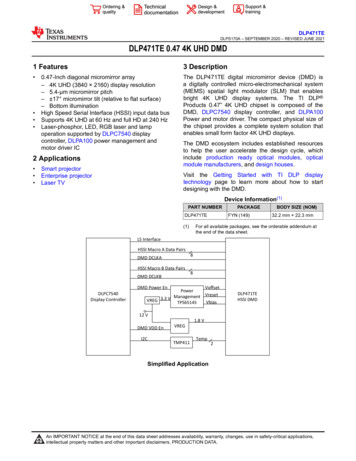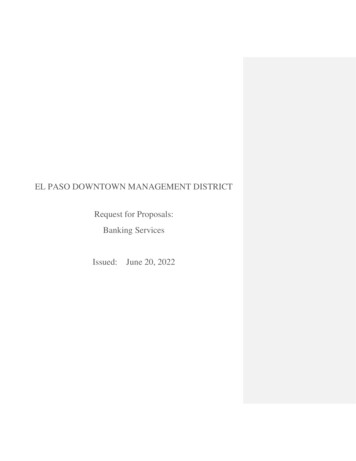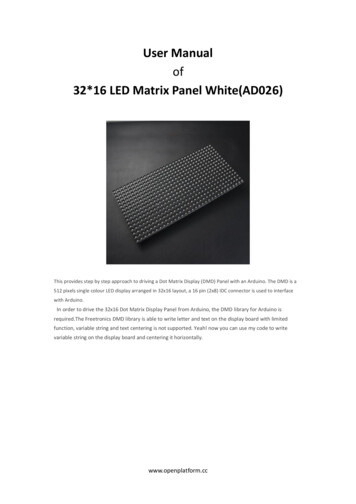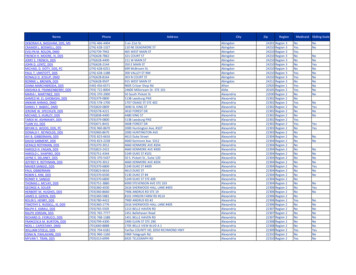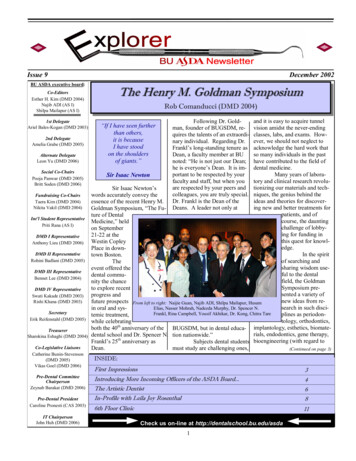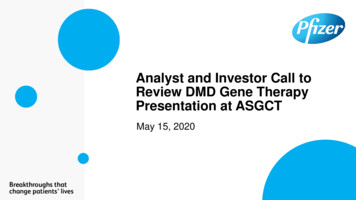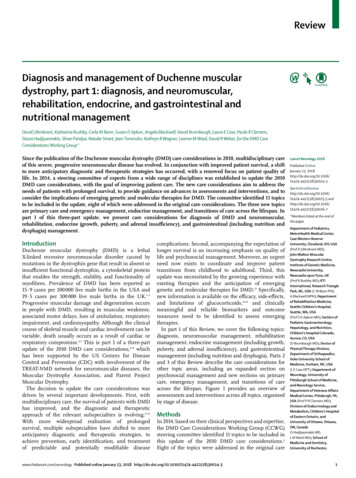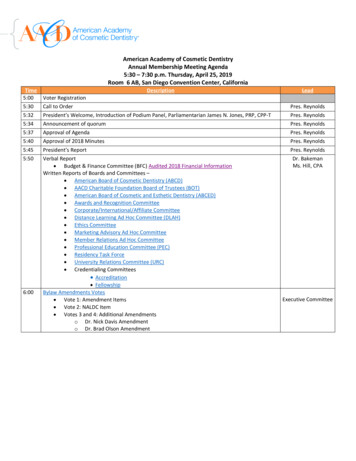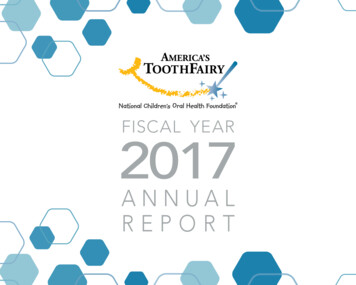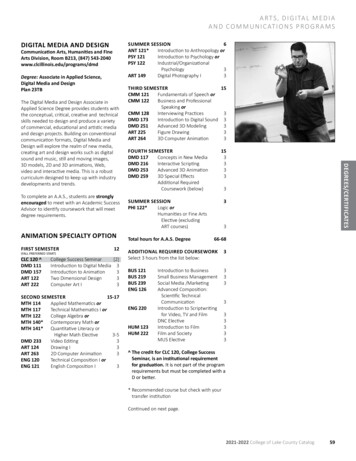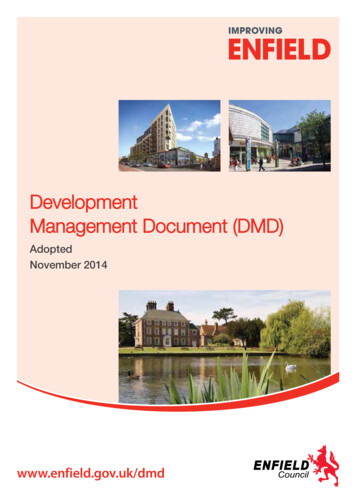
Transcription
DevelopmentManagement Document (DMD)AdoptedNovember 2014www.enfield.gov.uk/dmd
Enfield's Development Management Document Adopted (November 2014) Enfield CouncilForewordForewordBy building on the Core Strategy’s objectives and policies, this planning tool helps to meet the Council’s aim ofimproving the lives of everyone who lives, works, studies or plays in Enfield. Leading policies spelt out in thisdocument include ensuring sufficient quality affordable homes for families; supporting healthy living; and tacklingclimate change, for instance through energy efficiency standards and policies to help develop the Lee Valley HeatNetwork.Alongside of this, the key role played by Enfield’s town centres is also recognised, for their economic impact andbecause they are at the heart of our communities. The DMD therefore features policies aimed at protecting ourtown centres; nurturing their vitality; and ensuring that they remain competitive and responsive to retail, leisureand business trends.Another consideration is expanding upon Enfield’s Core Strategy and preserving the local character of our amenities,starting with the Green Belt, Metropolitan Open Land, public open space and other community infrastructure. Otherpolicies also protect the Borough’s conservation areas, historic buildings and landscapes, while ensuring thatstreets and open spaces remain safe and attractive for everyone to use and enjoy. The general focus here is onproviding guidance as to how development within Enfield might be shaped to accommodate change and continueto enhance our strong local identity.Lastly, Enfield Council has a policy of responding positively to today’s changing economic climate. Towards thisend, the DMD creates a robust yet flexible planning framework that supports economic growth and meets theneeds of local people and business. Policies in this area ensure that Enfield’s educational and skills provisionscontinue to improve, leading to greater employment and enterprise opportunity for the whole of our Borough.In short, the document incarnates the values of fairness, cohesion and growth and sustainability that are thehallmark of Enfield Council.Cabinet Member for Economic DevelopmentCouncillor Alan Sitkin
Enfield Council Enfield's Development Management Document Adopted (November 2014)Foreword
Enfield's Development Management Document Adopted (November 2014) Enfield CouncilContentsChapters1Introduction1.1 National and Regional Context1.2 Key challenges and supporting evidence1.3 Development Management Document1.3.1 The Policies Map1.3.2 Sustainable Development1.4 How this document will be used1.5 92.1 Affordable Housing2.2 Housing Size2.3 Existing Housing Stock and Residential Conversions2.4 Standards for New Development2.5 Residential Extensions2.6 Specialist Housing Needs3Community Facilities3.1 Community Facilities3.2 Early Years Provision3434364Enfield's Economy4.1 Introduction4.2 Strategic Industrial Location (SIL)4.3 Locally Significant Industrial Sites (LSIS)4.4 Complementary and Supporting Uses within SIL and LSIS4.5 Preventing the Loss of Industrial and Employment Capacity4.6 Market Demand and Viability Assessments4.7 New Employment Development4.8 Small Businesses3838383940414242435Town Centres and Shopping5.1 New Retail, Leisure and Office Development5.2 Enfield Town5.3 Angel Edmonton, Edmonton Green, Palmers Green and Southgate5.4 Local Centres and Local Parades5.5 Individual Shops and Small Clusters of Shops5.6 Floorspace above Commercial Premises5.7 Development Involving Tourism and Visitor Accommodation5.8 Managing the Impact of Food and Drink Establishments5.9 Managing the Impact of Betting Shops5.10 Evening Economy5.11 Banqueting Suites/ Function Halls5.12 Social Clubs464648495051525354555657576Design and Heritage6.1 Good Design6.2 Design considerations for Business Premises6.3 Design of Civic Buildings6.4 Tall buildings6.5 Heritage and built environment606062646567
Enfield Council Enfield's Development Management Document Adopted (November 2014)Contents7Transport and Parking7.1 Parking Standards7.2 Vehicle Crossovers7.3 Access and Servicing Development7.4 Assessing the Transport Implications of New Development72727475768Tackling Climate Change8.1 Sustainable Design and Construction8.2 Our Low Carbon Future8.3 Responsible Sourcing of Materials, Waste Minimisation and Green Procurement8.4 Conserving water8.5 Flood Risk8080829091939Environmental Protection9.1 Air Quality9.2 Land Contamination9.3 Hazardous Substances9.4 Noise9.5 Light Pollution9.6 Water Quality10210210410510610710810Green Infrastructure10.1 Open Space10.2 Play Space for Children and Young People10.3 Playing Pitches10.4 Waterways10.5 Wildlife Corridors and Green Chains10.6 Biodiversity and Ecological Enhancements10.7 Trees and Landscaping11011011111211311411511611Green Belt11.1 Protecting the Green Belt11.2 Development Adjacent to the Green Belt11.3 Areas of Special Character11.4 Agriculture11.5 Developed Sites in the Green Belt11.6 Crews Hill Defined Area120120121121122124125Appendices1Evidence Base1272Relationship to Unitary Development Plan (1994) Policies1293Sustainable Design and Construction Statements1374Housing1435Commercial Opening Hours1456Heritage Statements1497London Plan Car Parking and Cycle Standards1518Parking Standards1559Road Classifications15710Minimum Requirements for a Site Specific Flood Risk Assessment (FRA)161
Enfield's Development Management Document Adopted (November 2014) Enfield CouncilContents11Air Quality16312Hazardous Installations16713Requirements for Market Demand and Viability Assessments16914Glossary17315Supporting Maps15.1 Areas of Archaeological Importance15.2 Flood Risk Maps15.3 Source Protection Zones15.4 Existing tall buildings and important local views193193194195196
Enfield Council Enfield's Development Management Document Adopted (November 2014)Contents
Enfield's Development Management Document Adopted (November 2014) Enfield CouncilChapters7
Enfield's Development Management Document Adopted (November 2014) Enfield CouncilIntroduction8
Enfield's Development Management Document Adopted (November 2014) Enfield Council1 Introduction1 Introduction1.0.1The planning system helps to decide who can build what, where and how. The purpose of the planningsystem is to deliver sustainable development. Sustainable development is about directing developmentto the right locations and delivering high standards in all new development.1.0.2In 2010 the Council adopted its Core Strategy which sets the spatial planning framework for developmentof the borough over the next 10 to 20 years. It is a strategic document providing the broad strategy forthe scale and distribution of development and the provision of supporting infrastructure. It contains corepolicies for guiding patterns of development.1.0.3This Development Management Document, (DMD) provides detailed criteria and standard based policiesby which planning applications will be determined and will be a key vehicle in delivering the vision andobjectives for Enfield as set out in the Core Strategy.1.0.4The Core Strategy, DMD and Area Action Plans collectively form Enfield's Local Plan. Details of therelationship between these documents and Supplementary Planning Documents can be found in figure1.1. The most up to date information on the Local Plan work programme can be found in the Council'sLocal Development Scheme.1.0.5The Council submitted the DMD to the Government for public examination in January 2014. The Inspectorappointed to examine the DMD concluded that the DMD provided an appropriate basis for the planningof the borough, satisfied the requirements of Section 20(5) of the Planning & Compulsory Purchase Act2004 and met the criteria for soundness as set out in the National Planning Policy Framework.1.0.6The DMD evolved following three stages of formal public consultation. In July 2012 a Draft DMD waspublished for 12 weeks of consultation. In May 2013, the Council published the Proposed SubmissionDMD for a further 12 week period of consultation. The third and final consultation took place followingthe examination hearings, on the 'Main Modifications' set out by the Inspector, in June 2014.9
10Enfield Council Enfield's Development Management Document Adopted (November 2014)1 IntroductionFigure 1.1ENFIELD LOCAL PLAN:RELATIONSHIP OF COMPONENT DOCUMENTSCORE STRATEGYSITES SCHEDULEDEVELOPMENTMANAGEMENTPOLICIES MAPNORTHCIRCULAR AREAACTION PLANSouthgateTown HallENFIELDDESIGNGUIDEPlanning BriefNORTH EASTENFIELDNORTH LONDONJOINT WASTE PLANSection 106CommunityInfrastructureLevyNew SouthgateMaster PlanAREA ACTIONPLANPonders EndCentralPlanning BriefCENTRALLEESIDEAREA ACTIONPLANMeridian WaterMaster PlanStatement ofCommunityInvolvementEdmontonEco-ParkPlanning BriefKEYPicketts LockPlanning BriefDevelopment Plan DocumentsEDMONTON GREENMASTER PLANSupplementary Planning DocumentsENFIELD TOWNMASTER PLANOther Documents
Enfield's Development Management Document Adopted (November 2014) Enfield Council1 Introduction1.1 National and Regional ContextNational Planning Policy Framework (NPPF)1.1.1As part of the Localism agenda and the passing of powers from Central Government to Local Government;communities and individuals, the Government published its National Planning Policy Framework (NPPF)in March 2012. Replacing the previous Planning Policy Guidance Notes and Statements, the NPPF setsout the Government's planning policies and how these are expected to be applied.1.1.2The NPPF must be taken into account in the preparation of local plans and is a material considerationin planning decisions. It provides the framework within which local people and their accountable councilscan produce their own distinctive local plans which reflect the needs and priorities of their communities.This DMD, prepared in consultation with Enfield's communities, reflects local needs and priorities.1.1.3The DMD is consistent with the NPPF. Alongside the Core Strategy, it contributes towards theachievement of sustainable development, sets out opportunities for development and clear guidanceon what will or will not be permitted. The DMD is being prepared alongside the development of Enfield'sCommunity Infrastructure Levy (CIL) to ensure that the costs associated with policy compliance andinfrastructure delivery do not render developments unviable.London Plan1.1.4The London Plan (2011) and Revised Early Minor Alterations (2013) form part of the development planfor Enfield, providing both strategic guidance and development management policies to deliver strategicobjectives. The Mayor of London has also published Draft Further Alterations to the London Plan(January 2014), which are currently subject to examination. These further alterations are scheduled tobe incorporated into the London Plan in 2014/15.1.2 Key challenges and supporting evidence1.2.1The evidence base ensures that policies are based on sound principles. The evidence base, keychallenges and opportunities identified in chapter 2 and appendix 4 of the Core Strategy remain relevantto the preparation of this document.1.2.2A wide range of studies underpin the Core Strategy and these have been supplemented with furtherstudies and analysis on: housing need, employment land, town centre boundaries, flood risk, energy,open space, nature conservation, Green Belt boundaries, and tall buildings and view corridors. In additiona viability study is ongoing to inform both the Community Infrastructure Levy and the DevelopmentManagement Document. Further details are set out in the Appendix to this document: Appendix 1:'Evidence Base'.1.2.3The Council has also undertaken a Sustainability Appraisal to assess the impact of the DMD on thesocial, economic and environmental impacts of each policy. The Sustainability Appraisal Reportaccompanies this document.1.3 Development Management Document1.3.1Planning applications in Enfield will be determined using the adopted Core Strategy policies (2010),relevant policies in the London Plan, and the policies within this document. All previously 'saved' policieswithin the Council's Unitary Development Plan (1994) have expired or been replaced. Further detailsare provided in Appendix 2.1.3.2The Development Management Document will guide decisions on planning applications within Enfield.Each DMD policy links to one or more of the Core Strategy policies. The relationship to relevant corepolicies is highlighted throughout this document.11
12Enfield Council Enfield's Development Management Document Adopted (November 2014)1 Introduction1.3.3The document was prepared in consultation with residents, businesses, statutory bodies and Enfield'svoluntary and community sector. Further information about the consultation and details on how theresponses have informed this document are set out in the Consultation Report submitted alongside theDMD for examination.1.3.1 The Policies Map1.3.1.1This DMD is accompanied by the adopted Policies Map (2014). The Policies Map (2014) now supersedesthe Core Strategy Proposals Map (2010). The Policies Map shows land use designations referred to inpolicies set out in all adopted Local Plan documents including the Core Strategy and DMD. It will berevised each time a new Local Plan document is adopted.1.3.1.2To assist with the interpretation of DMD policies the following additional maps and diagrams are providedin Appendix 15:Areas of Archaeological Importance;Flood risk maps;Source Protection Zones;Existing tall buildings and important local views.1.3.2 Sustainable Development1.3.2.1In making decisions on planning applications, the Council will balance the need to promote economicgrowth, support social wellbeing, protect the environment and ensure the prudent use of natural resources.When considering development proposals the Council will take a positive approach that reflects the presumptionin favour of sustainable development contained in the National Planning Policy Framework. The Council willalways work proactively with applicants jointly to find solutions which mean that proposals can be approvedwherever possible, and to secure development that improves the economic, social and environmental conditionsin the area.Planning applications that accord with the policies in Enfield Local Plan documents will be approved withoutdelay, unless material considerations indicate otherwise. Where there are no policies relevant to the applicationor relevant policies are out of date at the time of making the decision then the Council will grant permissionunless material considerations indicate otherwise – taking into account whether:Any adverse impacts of granting permission would significantly and demonstrably outweigh the benefits,when assessed against the policies in the National Planning Policy Framework taken as a whole; orSpecific policies in that Framework indicate that development should be restricted.1.3.2.2The Council's Core Strategy sets out economic, social and environmental planning policies based onthe identified needs of the borough over the next 10-15 years. Taken together these policies define whatsustainable development is for the borough. Enfield's 2020 Sustainability Programme and Action Plan(2013) also demonstrates how these elements of sustainable development can simultaneously beachieved.1.3.2.3The development management policies within this document seek to ensure that decisions are madewhich deliver the economic, social and environmental components of sustainable development. Thiswill be delivered through policies which protect employment land and jobs, homes, community facilities,open space and natural habitats and through policies which set standards for sustainable design andconstruction, and energy savings.1.3.2.4A key element of sustainable development is ensuring the creation of sustainable communities. All newdevelopment is expected to play its part and should recognise and respond to the needs of communities,maximise opportunities to create sustainable communities and deliver accessible and inclusive
Enfield's Development Management Document Adopted (November 2014) Enfield Council1 Introductionenvironments. Developments will be expected to be of good design and be appropriately located. Inaccordance with the London Plan, new development should be designed to meet Lifetime Neighbourhoodprinciples.1.4 How this document will be used1.4.1The DMD contains policies for all types of planning application: from householder extensions to majorresidential, commercial and mixed use development. It will be used by the Council's Planning Officersand Planning Committee to make decisions on planning applications.1.4.2The policies and standards adopted within the DMD form an integral part of Enfield's Local Plan andwill be used alongside policies contained in the London Plan and Core Strategy to determine planningapplications. The policies have 'Development Plan' status as detailed in Section 38 of the Planning andCompulsory Purchase Act 2004.1.4.3The DMD policies will be supplemented with Area Action Plans and Neighbourhood Plans as theyemerge, which will also have Development Plan status.1.5 Implementation1.5.1Policies contained within this document will be implemented through the planning application decisionmaking process. Planning approvals, conditions, Section 106 agreements and Community InfrastructureLevy payments will be used to delivery infrastructure, facilities and services in line with the strategicdirection provided by the Core Strategy.1.5.2Further guidance on the implementation of policies will be provided through Supplementary PlanningDocuments such as the Enfield Design Guide.13
14Enfield Council Enfield's Development Management Document Adopted (November 2014)1 Introduction
Enfield's Development Management Document Adopted (November 2014) Enfield CouncilHousing15
16Enfield Council Enfield's Development Management Document Adopted (November 2014)2 Housing2 Housing2.1 Affordable HousingDMD 1Affordable Housing on Sites Capable of Providing 10 units or moreDevelopment should provide the maximum amount of affordable housing, having regard to:a.b.the borough-wide affordable housing target of 40%; andthe need to provide an appropriate mix of tenures to meet local housing need and reflect a boroughwide target of 70% social rent and Affordable Rent; and 30% intermediate.Any negotiations will take into account the specific nature of the site; development viability; the need to achievemore mixed and balanced communities; particular priority to secure affordable family homes which meet bothlocal and strategic needs; available funding resources; and evidence on housing need.Mixed tenure residential development proposals must be designed to be ‘tenure blind’, so that the schemeas a whole is well integrated, cohesive and complementary. Tenure should be spread throughout thedevelopment to prevent concentrations or clear distinctions.This policy should be read in conjunction with Core Strategy policy 3.Justification and guidance on implementation2.1.1Following the publication of the NPPF, affordable housing now comprises of three tenures: social rent,Affordable Rent, and intermediate housing. Underpinned by evidence contained within Enfield's AffordableHousing Economic Viability Study (AHEVS) (2010) and Local Plan Viability Study (2013), the DMD policyclarifies the position with regards to the borough-wide targets for tenure mix as set out in the CoreStrategy.2.1.2Social rented accommodation is defined in the NPPF as 'rented housing owned and managed by localauthorities and registered social landlords, for which guideline target rents are determined through thenational rent regime'. The rents charged for social rented housing can differ depending on whether it isprovided by registered social landlords or the local authority. Average rents for social rented housing inEnfield across the range of diffe
management document (dmd) adopted november 2014. foreword . enfield local plan : relationship of component documents. sites schedule core strategy policies map north london joint waste plan north circular area action plan . enfiel
